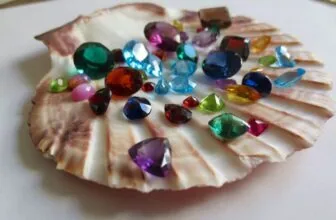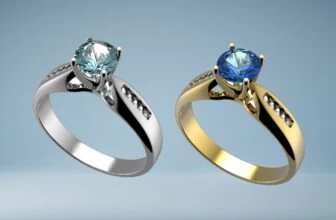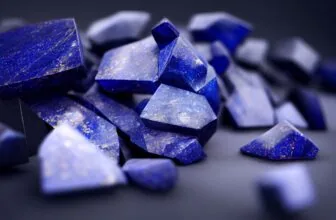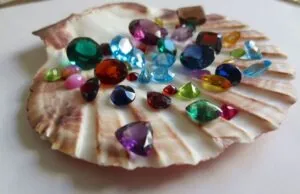
Table of Contents
The color grey is not typically associated with jewelry because grey is an uncommon color in the jewelry world. There are only very few gemstones that are primarily grey in color.
However, because of this rarity, grey gemstones are actually very intriguing when crafted into jewelry. While they may not jump out at you with the intensity of say, a red gemstone, grey gemstones have a subdued beauty.
Grey is a neutral color that goes well with other colors. It is the perfect combination of black and white and represents balance, sophistication, and compromise. Grey goes with any outfit and tends to suit most skin tones. If you’re looking to buy a grey gemstone, here are the 27 most popular options used in jewelry.
Grey Gemstone list
1. Grey Diamonds
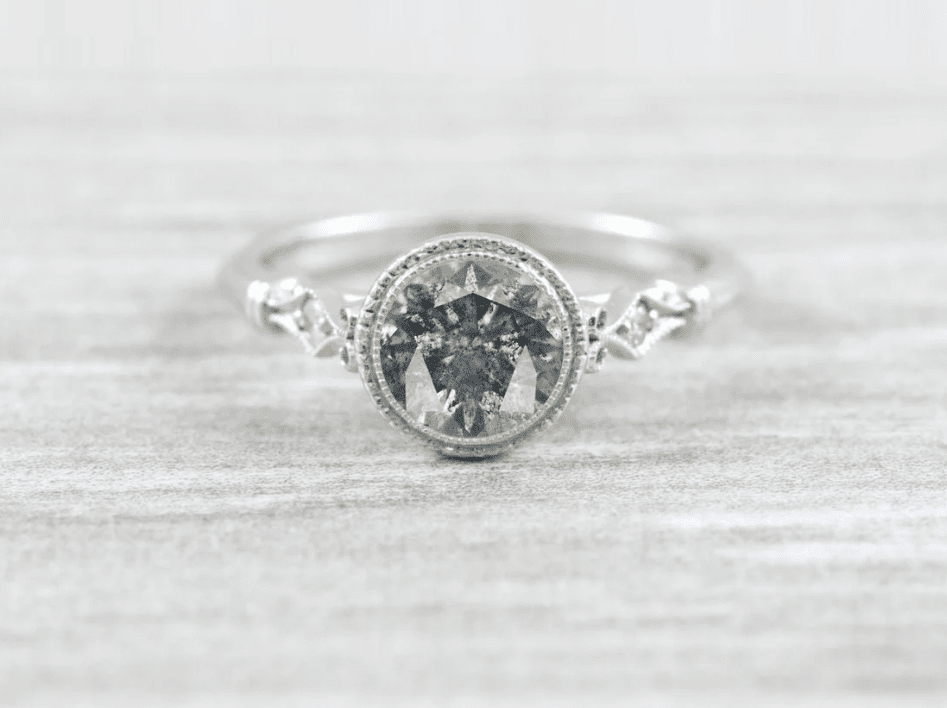
Grey diamonds have been increasing in popularity lately as the demand for uncommon gemstones increases. Grey diamonds get their color from the inclusion of hydrogen in its composition. The range of color in grey diamonds is wide and varies from Faint Grey to Fancy Dark Grey.
In the diamond industry, these shades are given nicknames such as charcoal grey, pigeon and silver, to identify the color. The beauty of a grey diamond is in the balance it offers – it’s not as traditional as colorless diamonds nor as unorthodox as black diamonds. It has just the right touch of mystery and irregularity.
Grey diamonds are also relatively affordable compared to most other colored diamonds. With its exceptional durability (10 Mohs) and sparkle, these diamonds are perfect for a non-conventional piece of jewelry.
2. Grey Moonstone

From all the grey gemstone options, moonstone is probably the most well-known and sought-after. It’s commonly translucent in appearance, and ranges in color from colorless to dark grey.
While moonstone is an attractive gemstone, it’s not highly durable (6 to 6.5 Mohs) and doesn’t suit jewelry that get exposed. It’s suitable for pendants, earrings, bracelets, hair combs and other types of jewelry that are more protected. Moonstone rings aren’t recommended due to the stone’s relatively softness, however, if taken reasonable care of, they can last a long time.
Moonstones are often cut en cabochon to enhance the luster and smooth sheen of the stone, although they’re sometimes faceted as well. Raw unpolished grey moonstone has an eye-catching rustic simplicity that is beautiful when set into well-crafted jewelry.
3. Grey Agate
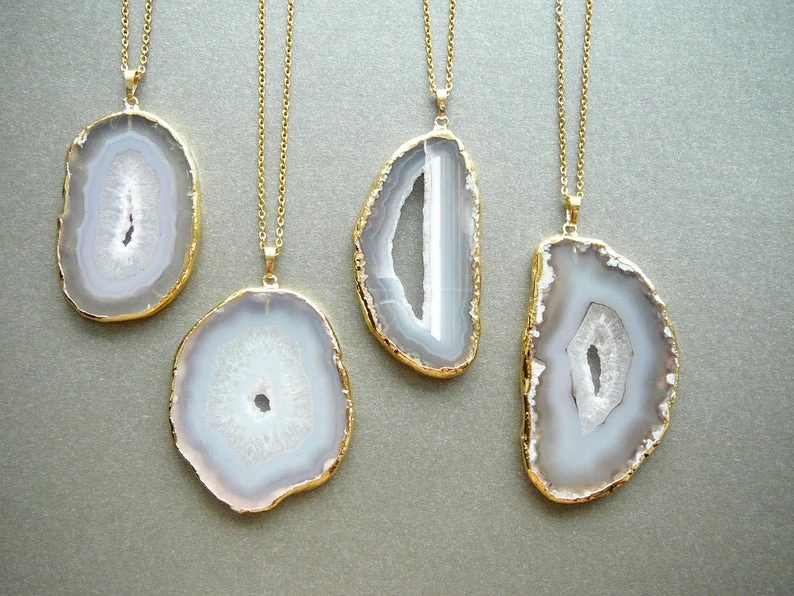
Agate is a common gemstone that comes in almost every color of the rainbow. Of these, grey agate is typically found in either a unicolor appearance or banded with layers of white.
Agate is often translucent, which makes it ideal for cabochons. Grey agate has a smooth, beautiful sheen and a waxy to vitreous luster. Because of its affordability, it’s an excellent gemstone for all types of jewelry, particularly large costume pieces. Agate has good durability (Mohs 7) and doesn’t require much maintenance.
4. Mother of Pearl

Mother-of-pearl is made of nacre, much like traditional pearls, but it’s taken from the inner layers of the mollusk’s shell. This organic substance is highly iridescent and can be made into various types of jewelry as well as carvings and figurines. It is perfect for carvings and for inlay jewelry, as well as pendants and earrings, but not so much for rings. Like all organic gemstones, mother-of-pearl is soft (2.5 to 4.5 Moh) and can easily get damaged or scratched.
Mother-of-pearl is opaque to translucent in appearance and has a pearly luster. It’s easily available and very affordable, making it an excellent alternative to pearls. Note that mother-of-pearl ranges in color and is generally faint gray.
Because of its iridescence, it is especially beautiful when seen under lights in jewelry that allows for movement. This enhances its sparkle and exhibits the colors that flash from the gemstone.
5. Grey Pearl

Pearls are traditionally white, but they come in an array of colors. Grey pearls are an ideal break from tradition while still exhibiting the luster and sophisticated look that pearls are famous for.
Grey pearls come in a range of hues, from a faint dusty grey to a darker, metallic gunmetal grey. Most grey pearls on the market are cultured and often enhanced.
Like all organic gemstones, they’re very soft, ranking at only 2.5 on the Mohs scale. Grey pearls are easily abraded and can break or chip if subject to heavy pressure. They are not ideal to be worn in everyday jewelry and require proper care and maintenance to keep them lustrous and protected.
6. Grey Labradorite

Labradorite is a plagioclase feldspar, among the most common and abundantly found minerals. It is not a very hard gemstone (6 to 6.5 Mohs) but due to its compact structure, it is a tough stone. It’s used in all types of jewelry but is especially beautiful when set in bohemian and gypsy styles. However, it can work in stylish and sophisticated designs too, as seen in the image above.
Labradorite is typically grey or grey-black in appearance, but its iridescence gives it a colorful and dynamic look. This iridescence is known as labradorescence – a flashy display of color that occurs in opaque varieties of labradorite.
Transparent labradorites are beautiful but they don’t display this iridescent and aren’t as valuable as the opaque varieties. Most grey labradorite will have this desirable labradorescence due to the dark body tone.
7. Grey Chalcedony

Another common gemstone, grey chalcedony is abundant and affordable. It has an opaque to waxy luster, and the microcrystalline structure of the gemstone gives it its characteristic toughness. What this means is that the gemstone does not contain any crystal formations within it but is instead smooth, compact and tough.
What’s more, grey chalcedony has no cleavage which refers to a gemstone’s tendency to break. This, coupled with the stone’s hardness ranking of 6.5 to 7 Mohs, makes grey chalcedony ideal for all types of jewelry.
8. Grey Tourmaline

Tourmaline is known as the rainbow gemstone, because it comes in all colors. While grey isn’t its most popular color, grey tourmaline makes for stunning jewelry. It’s also reasonably priced and easily available.
Grey tourmaline has a vitreous luster and is often faceted to enhance its brilliance. It has excellent transparency and sparkle and is also a durable gemstone (Mohs 7 to 7.5). These gemstones are also resistant to breakage.
Grey tourmaline is often free of visible inclusions and have very good clarity. They can be cut into traditional gemstone shapes such as the emerald cut, pear, marquise and brilliant shapes and other unique fancy cuts.
9. Fluorite
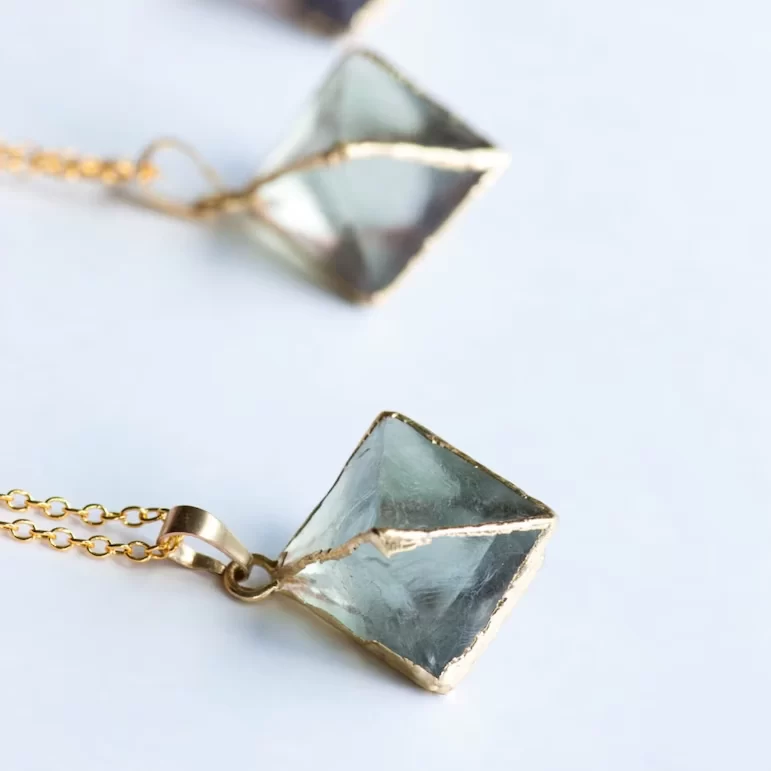
Fluorite is a mineral that typically forms in a cubic or octahedral crystal structure, although it can also occur in other shapes. It is commonly found in a variety of colors, including grey, purple, blue, green, yellow, and clear. Fluorite is known for its fluorescence, which means it glows under ultraviolet light.
In terms of hardness, fluorite has a Mohs hardness scale rating of 4, which means it is relatively soft compared to other gemstones. This means that it is susceptible to scratches and damage if it is not handled carefully. Despite this, fluorite is still a popular gemstone due to its unique colors and fluorescent properties, as well as its use in various industries such as the production of aluminum and other metals.
10. Hematite

Hematite is a mineral that is commonly found in iron ore deposits around the world. It is often referred to as a “healing stone” because of its believed therapeutic properties. The name hematite comes from the Greek word for blood, as it has a reddish-brown color when powdered.
Hematite has a distinctive metallic luster and is one of the heaviest minerals on Earth. It has a hardness of about 5.5-6.5 on the Mohs scale, which means it is relatively durable and resistant to scratches. Hematite is used in a variety of applications, including as a pigment for paint and in the production of iron and steel. It is also a popular gemstone, often used in jewelry and other decorative objects due to its metallic shine and unique appearance.
11. Grey Sapphire

Grey sapphire is a type of sapphire gemstone that is typically found in shades of gray or black. Like other sapphires, it is a variety of the mineral corundum and is valued for its hardness, durability, and luster. Grey sapphire is often used in jewelry, particularly in engagement rings, due to its unique color and elegant appearance.
Sapphires are typically known for their blue color, but they can also occur in a range of other colors, including pink, yellow, green, and gray. Grey sapphire is less common than other colors, but it is still highly prized by gemstone enthusiasts and jewelry designers alike. Grey sapphire is also believed to have healing properties, including the ability to promote mental clarity and spiritual growth.
12. Spinel

Grey spinel occurs in various shades of gray, ranging from pale silver to deep charcoal. Spinel is a mineral that is often mistaken for other gemstones, such as ruby and sapphire, due to its similar appearance. However, spinel has its own unique qualities that make it highly sought after, including its high refractive index and excellent durability.
Grey spinel is a popular choice for jewelry due to its neutral color and versatility. It can be paired with a wide range of other gemstones and metals, making it a popular choice for engagement rings, earrings, necklaces, and other jewelry pieces. Grey spinel is also believed to have spiritual and healing properties, including the ability to promote clarity of thought, increase energy levels, and reduce stress and anxiety.
13. Grey Aventurine

Grey aventurine is typically found in shades of gray or silver, with occasional flecks of glittering mica that give it a distinctive sparkle. Aventurine is a form of quartz that is typically opaque and has a smooth, polished surface. It is often used in jewelry and decorative objects due to its unique appearance and availability in a range of colors.
Grey aventurine is believed to have healing properties, including the ability to promote mental clarity, calmness, and emotional balance. It is also believed to have grounding and protective qualities that can help to ward off negative energies and promote a sense of inner peace.
Grey aventurine is a popular choice for jewelry designers looking to incorporate a unique and elegant gemstone into their designs, and it is often paired with other stones and metals to create stunning pieces that are both fashionable and functional.
14. Gray Chrysoprase
Grey chrysoprase is a unique and beautiful variety of chalcedony that is characterized by its muted gray color. While chrysoprase is typically associated with shades of green, the gray variety is less common but highly prized for its subtle, understated beauty.
Grey chrysoprase is a popular choice for jewelry designers due to its unique appearance and versatile nature. It can be used in a variety of designs, from delicate and understated to bold and statement-making. Grey chrysoprase is often paired with other gemstones and metals, such as gold or silver, to create stunning pieces that are both fashionable and functional.
In addition to its aesthetic appeal, grey chrysoprase is believed to have healing properties, including the ability to promote emotional balance, reduce stress and anxiety, and increase feelings of love and compassion. This makes it a popular choice for individuals who are interested in using gemstones for their spiritual and therapeutic benefits.
15. Gray Opal

Gray opal is a popular gemstone in the world of jewelry due to its unique and striking appearance. This type of opal is known for its gray or bluish-gray body color with flashes of green, blue, or even pink when viewed from different angles.
The mesmerizing play of colors in gray opals makes them a favorite among jewelry designers and consumers alike. Additionally, they are often opaque and have a waxy luster, which adds to their appeal as statement pieces.
Another advantage of gray opals is that they are relatively affordable compared to other opal varieties, making them accessible to a wide range of consumers. Overall, gray opals are a versatile gemstone that can add a touch of beauty and sophistication to any jewelry collection.
16. Gray Peacock Ore
Peacock ore, also known as Bornite, is a sulfide mineral that is commonly found in copper mines around the world. It is named after its vibrant and iridescent colors that resemble the feathers of a peacock. The mineral’s chemical composition consists of copper, iron, and sulfide, which gives it a metallic sheen and an unusual iridescent coloration.
Peacock ore is primarily used as an ornamental stone due to its unique and eye-catching appearance. It is often used in jewelry-making, decorative objects, and even as a mineral specimen for collectors.
This gemstone is also believed to have spiritual and healing properties. It is said to enhance creativity and promote self-expression while also stimulating energy and positivity. Overall, peacock ore is a fascinating mineral that offers both aesthetic and metaphysical value.
17. Gray Pietersite

Pietersite is a rare and beautiful gemstone that was first discovered in Namibia in 1962 by Sid Pieters. It is a type of chalcedony that contains a mix of fibers and bands of various colors, including blues, golds, browns, and even gray.
The unique mix of colors and patterns within pietersite makes each stone one-of-a-kind. This gemstone is typically used in jewelry-making to create statement pieces such as rings, necklaces, and bracelets. It is often cut en cabochon to highlight its unique patterns and colors.
Pietersite is considered a moderately hard stone, with a Mohs hardness scale rating of 6.5-7, making it suitable for everyday wear. Its rarity and unique appearance have made pietersite a sought-after gemstone among collectors and jewelry enthusiasts alike.
18. Gray Prehnite

Prehnite is a pale green to yellow-green mineral that is often used in jewelry-making due to its unique and attractive appearance. Also found in gray, it is a type of silicate mineral that is composed of calcium and aluminum. Prehnite can be found in various locations around the world, including Australia, South Africa, and the United States.
It is typically used to create statement pieces such as necklaces, earrings, and bracelets. Prehnite is a relatively soft stone, with a Mohs hardness scale rating of 6-6.5, which makes it suitable for use in jewelry but also means that it requires extra care to avoid scratches or damage.
19. Gray Quartzite

Quartzite is a metamorphic rock that is primarily composed of quartz grains that have been fused together by heat and pressure. It is known for its durability and resistance to wear and tear, which makes it a popular material for use in jewelry-making. Quartzite can be found in a variety of colors, including white, gray, pink, and green.
While it can appear gray in color, this is not the only color that it comes in. In jewelry, quartzite is often used as a decorative stone or accent due to its unique texture and color variations. It can be cut into various shapes and sizes and polished to a high shine.
Quartzite is a hard stone, with a Mohs hardness scale rating of 7, making it a durable and long-lasting material for jewelry-making. Overall, quartzite is a versatile and attractive material that offers many possibilities for creative jewelry designs.
20. Gray Rhodonite
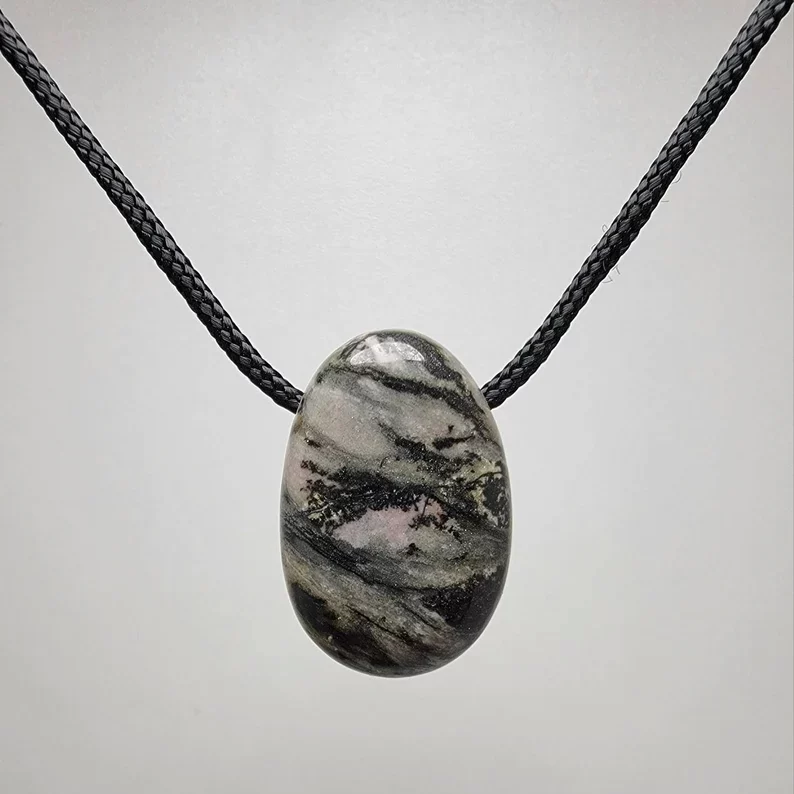
Rhodonite is a pink to red-brown colored mineral that is often used in jewelry-making due to its unique appearance and properties. It is composed of manganese, iron, magnesium, and calcium, and is found in metamorphic rocks around the world.
While rhodonite is not typically gray in color, it can sometimes contain gray streaks or patches. In jewelry, rhodonite is often used to create statement pieces such as necklaces, pendants, and earrings. It is a relatively hard stone, with a Mohs hardness scale rating of 5.5-6.5, which makes it suitable for use in everyday jewelry.
Rhodonite is also believed to have healing properties, particularly in promoting emotional healing and reducing stress and anxiety. It is sometimes referred to as the “stone of love” due to its association with the heart chakra.
21. Gray Rhyolite

This volcanic rock is composed primarily of quartz, feldspar, and other minerals. It is typically gray in color, although it can sometimes have other colors present in its patterns and textures, such as white, black, or brown.
Gray rhyolite is often used in jewelry-making due to its unique appearance and durability. It is a relatively hard stone, with a Mohs hardness scale rating of 6-7, which makes it suitable for use in a variety of jewelry designs.
Gray rhyolite is often used as a decorative stone or accent in necklaces, bracelets, and earrings. It can be cut and polished to a high shine, and its unique patterns and colors make it a popular choice for creating one-of-a-kind jewelry pieces.
22. Silver Sheen Obsidian

Silver sheen obsidian is a type of volcanic glass that is composed of silicon dioxide and other minerals, which create the stone’s distinctive sheen. While it is often black in color, silver sheen obsidian can also have gray or silver streaks and highlights.
In jewelry-making, silver sheen obsidian is often used as a decorative stone or accent, particularly in statement pieces such as necklaces, pendants, and earrings. It can be cut into various shapes and sizes and polished to a high shine to enhance its unique sheen.
Silver sheen obsidian is a relatively hard stone, with a Mohs hardness scale rating of 5-5.5, which makes it suitable for use in everyday jewelry. Additionally, silver sheen obsidian is believed to have spiritual properties, particularly in promoting self-reflection and inner growth.
23. Grey Turquoise
Grey turquoise is a rare and unique type of turquoise that is characterized by its gray or black matrix and light blue to green coloration. The stone is formed from the mineral deposits of copper, aluminum, and phosphorus, which give it its distinctive appearance.
Grey turquoise is soft with a Mohs hardness scale rating of 5-6, making it suitable for use in jewelry that will not be subject to hard impacts. In jewelry-making, grey turquoise is often used as a centerpiece or accent stone in necklaces, bracelets, and earrings.
Its unique matrix and color make it a popular choice for bohemian and southwestern-inspired jewelry designs. Grey turquoise is also believed to have spiritual properties, particularly in promoting healing and communication.
24. Zebra Stone
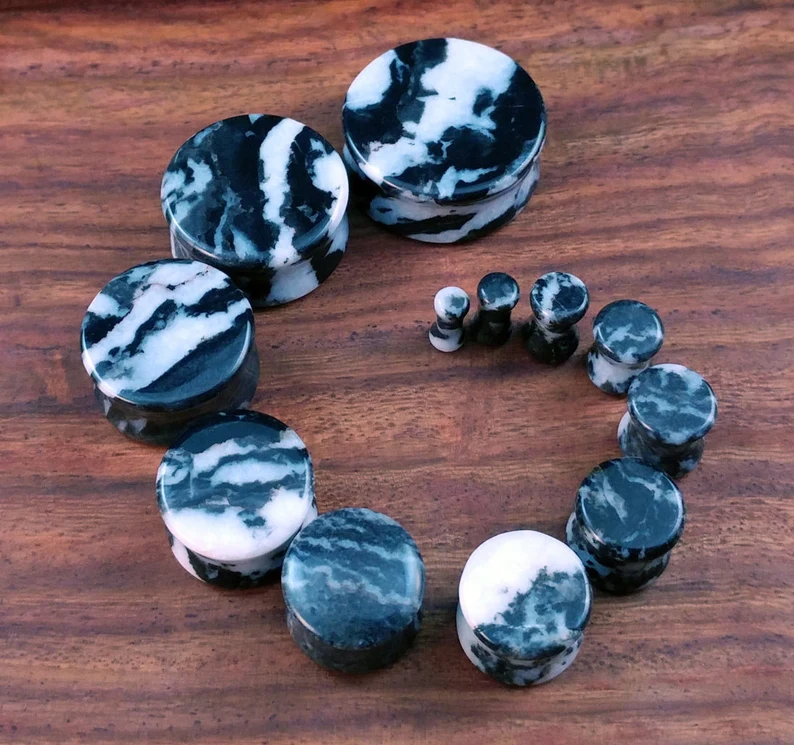
Zebra stone is a unique and striking stone that is characterized by its black and white stripes, which resemble the stripes of a zebra. It is a type of sedimentary rock that is composed primarily of quartz and other minerals, such as clay and iron oxide.
The stone’s distinctive stripes are formed from the alternating layers of different minerals that make up the stone. Zebra stone is often used in jewelry-making as a decorative stone or accent, particularly in statement pieces such as necklaces and pendants. It can be cut into various shapes and sizes and polished to a high shine to enhance its unique pattern.
Zebra stone is relatively hard, with a Mohs hardness scale rating of 6-7, which makes it suitable for use in a variety of jewelry designs. Additionally, zebra stone is believed to have grounding and balancing properties, particularly in promoting a sense of calm and stability.
25. Smithsonite
Smithsonite is a rare and unique mineral that is characterized by its varied shades of gray, green, blue, and pink. It is a type of zinc carbonate that is often found in association with other zinc minerals, such as sphalerite and galena.
Smithsonite is often used in jewelry-making as a decorative stone or accent, particularly in necklaces, pendants, and earrings. It can be cut into various shapes and sizes and polished to a high shine to enhance its unique coloration. Smithsonite is a relatively soft stone, with a Mohs hardness scale rating of 4-5, which makes it suitable for use in jewelry that will not be subject to hard impacts.
Additionally, smithsonite is believed to have healing properties, particularly in promoting emotional balance and helping to overcome past traumas.
26. Grey Vesuvianite
Vesuvianite, also known as idocrase, is a mineral that comes in various colors, including gray, green, brown, yellow, and red. The gray variation of vesuvianite is less common and is typically found as a secondary mineral in volcanic and metamorphic rocks.
It is often used in jewelry-making as a decorative stone or accent, particularly in necklaces, earrings, and bracelets. Vesuvianite is a relatively hard stone, with a Mohs hardness scale rating of 6.5, which makes it suitable for use in a variety of jewelry designs. Its unique coloration and texture make it a popular choice for both modern and vintage-inspired jewelry styles.
This gemstone is believed to have healing properties, particularly in promoting spiritual and emotional balance. It is said to enhance creativity, intuition, and communication, making it a valuable stone in meditation and spiritual practices.
27. Grey Tektite

Tektites are natural glasses formed from terrestrial debris ejected during meteorite impacts. They are typically black or dark brown in color, but some varieties can be gray in color as well. Tektites are often used in jewelry-making as decorative stones or accent pieces, particularly in necklaces, pendants, and earrings.
They are popular in contemporary and edgy jewelry designs, and their unique and unusual origins make them popular among collectors as well. Tektites are relatively hard stones, with a Mohs hardness scale rating of 5.5-7, which makes them suitable for use in a variety of jewelry designs. Due to their rarity and unique origins, tektites can be quite valuable and are often used in high-end jewelry pieces.
Which Grey Gemstone Should I Choose?
For Engagement Rings
There are several grey gemstones that are ideal for engagement rings, depending on your preferences and budget. Some popular options include:
- Grey diamonds: Grey diamonds are unique and have become increasingly popular in recent years. They offer a modern and unconventional look that stands out from traditional white diamonds. Grey diamonds are also durable and have a hardness rating of 10 on the Mohs scale, making them a great choice for everyday wear.
- Grey sapphires: Grey sapphires are another popular option for engagement rings. They are known for their durability and have a hardness rating of 9 on the Mohs scale. Grey sapphires offer a more affordable alternative to grey diamonds and come in a variety of shades, from light to dark grey.
- Moissanite: While not a natural stone, moissanite is a popular choice for engagement rings due to its affordability, durability, and unique grey hues. Moissanite is a lab-created gemstone that offers a similar look to diamonds but at a fraction of the cost. It has a hardness rating of 9.25 on the Mohs scale, making it a durable option for daily wear.
Ultimately, the ideal grey gemstone for an engagement ring will depend on your personal style, preferences, and budget.
For Costume and Fashion Jewelry
There are many grey gemstones that are ideal for costume and fashion jewelry, as they offer a unique and trendy look at an affordable price point. Some examples include:
- Grey moonstone: Grey moonstone is a semi-translucent gemstone with a pearly sheen. It is often used in bohemian-inspired jewelry and is a popular choice for stacking rings and delicate necklaces.
- Labradorite: Labradorite is a grey gemstone with iridescent flashes of blue, green, and gold. It has a mystical and otherworldly look that is often used in statement earrings and bohemian necklaces.
- Hematite: Hematite is a dark grey gemstone that is often used in bold statement pieces. It has a metallic sheen and is popular in chunky bracelets and long necklaces.
- Grey agate: Grey agate is a banded gemstone with shades of grey, white, and black. It is often used in bohemian-inspired jewelry and is popular in chunky rings and statement necklaces.
Ultimately, the ideal grey gemstone for costume and fashion jewelry will depend on the specific style and design of the piece.
Soft Grey Gemstones
Soft gemstones are those that have a lower ranking on the Mohs scale of mineral hardness, typically below 6.5. Some examples of soft grey gemstones include pearls, opals, and malachite.
Soft grey gemstones can be used for a variety of jewelry designs and styles, but they may require extra care and caution during wear and cleaning to prevent damage. For instance, pearls are often used in delicate and feminine jewelry designs, while opals can be used in bohemian and vintage-inspired pieces. Malachite is a popular choice for statement rings and earrings due to its unique green-grey banding.
It’s important to note that while soft gemstones may not be as durable as harder stones, they can still make stunning additions to jewelry designs when used properly and with care. When selecting soft gemstones for jewelry, it’s important to consider the specific design and use of the piece, as well as the level of care that will be required for the gemstone.
Where to Shop for Grey Gemstones
Grey is not a highly sought-after color in the jewelry world and traditional retailers may not typically store grey gemstone jewelry. However, if you take your search online, there will be more options available to you.
- Etsy is our top pick for grey gemstones, simply because of the endless choice available to you. What’s more, you can find a wide variety of jewelry including vintage, antique and artisan jewelry.
- Amazon has a good range of grey gemstone jewelry but will require sifting through and careful searching to find what you are looking for. Also, be scrupulous and check the authenticity of the gemstone including its origins, if applicable. Always keep a line of communication open with the vendor and ask questions about the gemstone you are eyeing.
- Angara Jewelers offers a range of grey gemstones and jewelry. Customers can choose from a variety of jewelry types, such as rings, earrings, necklaces, and bracelets, as well as different metal options such as silver, gold, and platinum. The store also offers customization options, allowing customers to design their own unique pieces of grey gemstone jewelry.
- Blue Nile is a leading online retailer of high-quality gemstones and jewelry, including a wide selection of beautiful and unique grey gemstones. Their jewelry is crafted with only the finest materials, including sterling silver, 18k gold, and platinum, and is backed by a lifetime warranty.
- James Allen: With a commitment to quality and customer satisfaction, James Allen is a great option for those looking to purchase grey gemstones and jewelry. They provide free shipping and returns, as well as 24/7 customer service to ensure a smooth and seamless shopping experience.
FAQs about Grey Gemstones
What are grey gemstones?
Grey gemstones are precious or semi-precious stones that are primarily gray in color.
Are all grey gemstones hard?
No, not all grey gemstones are hard. Some may be relatively soft, requiring extra care and attention when being set in jewelry.
What are some examples of grey gemstones?
Some examples of grey gemstones include gray diamonds, labradorite, hematite, and gray moonstone.
Are grey gemstones expensive?
The price of grey gemstones can vary greatly depending on factors such as rarity, size, and quality.
Can grey gemstones be used for engagement rings?
Yes, some grey gemstones such as gray diamonds and sapphires can be used for engagement rings.
Can grey gemstones be used in fashion jewelry?
Yes, grey gemstones can be used in fashion jewelry to create unique and stylish pieces.
Are grey gemstones popular in men’s jewelry?
Yes, grey gemstones are often used in men’s jewelry, especially for pieces such as cufflinks and tie pins.
Do grey gemstones have any unique properties or meanings?
Some grey gemstones such as labradorite and hematite are believed to have grounding and protective properties, while others such as gray moonstone are associated with intuition and emotional balance.
Can grey gemstones be treated or enhanced?
Some grey gemstones can be treated or enhanced to improve their color or clarity, but this can affect their value and durability.
How do I care for my grey gemstone jewelry?
To care for grey gemstone jewelry, it is important to avoid exposure to harsh chemicals, excessive heat, and sunlight. Regular cleaning and gentle handling can also help to keep grey gemstone jewelry looking its best.
Wrapping Up
Grey gemstones offer a wide range of options for jewelry lovers seeking unique and elegant pieces. From the cool elegance of gray diamonds to the earthy charm of gray agate, there is a grey gemstone for every style and preference.
Whether you’re looking for a statement piece or a subtle accent, grey gemstones can add a touch of sophistication and refinement to any jewelry collection. While some grey gemstones may require extra care and attention due to their softness or unique properties, their beauty and versatility make them a worthwhile addition to any jewelry collection.


